 W
WPseudogarypus synchrotron is an extinct species of pseudoscorpion in the family Pseudogarypidae known from only two Eocene fossils found in Europe. P. synchrotron is one of four species in the genus Pseudogarypus to have been described from fossils.
 W
WAcalitus brevitarsus is an eriophyid mite which induces domed, blister like swellings, known as galls, on some species of alder.
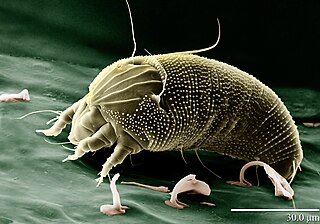 W
WAceria anthocoptes, also known as the russet mite, rust mite, thistle mite or the Canada thistle mite, is a species of mite that belongs to the family Eriophyidae. It was first described by Alfred Nalepa in 1892.
 W
WAceria fraxinivora, also known as the cauliflower gall mite and the ash key gall, causes the growths, known as galls, found on the hanging seeds or "keys" of the common ash tree.
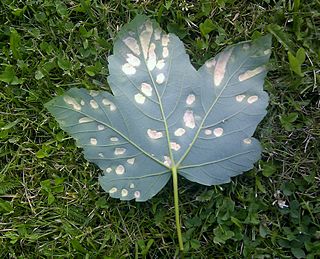 W
WAceria pseudoplatani causes the sycamore felt gall that is found on the leaves of sycamores or Norway maple, and is caused by an acarine gall-mite.
 W
WAceria sheldoni, commonly called the citrus bud mite, is a species of mite belonging to the family Eriophyidae. It feeds in leaf- and flower-buds of Citrus spp., causing deformation to leaves, flowers and fruit, and is a worldwide pest of citrus fruit production.
 W
WAculus laevis is a species of mite which causes galls on the leaves of sallows. It was first described by Alfred Nalepa in 1892.
 W
WAculus magnirostris is a species of mite which causes galls on the leaves of willows. It was first described by Alfred Nalepa in 1892.
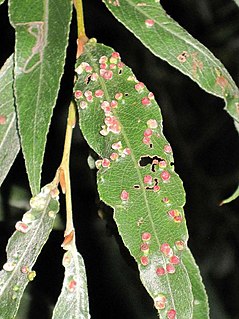 W
WAculus tetanothrix is a species of mite which causes galls on the leaves of willows. It was first described by Alfred Nalepa in 1889.
 W
WAculus truncatus is a species of mite which causes galls on the leaves of purple willow. It was first described by Alfred Nalepa in 1892.
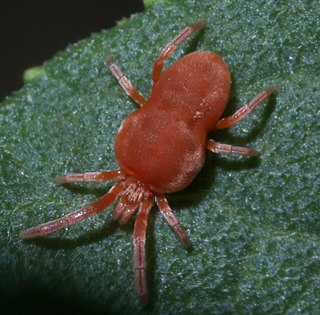 W
WAllothrombium is a genus of mites belonging to the family Trombidiidae.
 W
WBrevipalpus phoenicis, also known as the false spider mite, red and black flat mite, and in Australia as the passionvine mite, is a species of mite in the family Tenuipalpidae. This species occurs globally, and is a serious pest to such crops as citrus, tea, papaya, guava and coffee, and can heavily damage numerous other crops. They are unique in having haploid females, a condition caused by a bacterium that change haploid males into females.
 W
WCecidophyopsis ribis is an eriophyid mite which is best known for being a plant parasite, a pest of Ribes species, the genus that includes gooseberries and blackcurrants.
 W
WDicranopalpus ramosus is a species of harvestman. Males are up to 4 mm long, females can reach up to 6 mm. Both sexes have very long legs, with a distinct elongated apophysis that reaches almost to the end of the tibia. This makes their pedipalps look forked. Their body is brownish with dark markings, the females being lighter colored.
 W
WEriophyes inangulis is a mite that forms the alder vein angle gall. It develops in a chemically induced gall; a sub-spherical distortion rising up from the upper surface of the leaves of alder trees Alnus glutinosa along the midrib. Synonyms are Eriophyes laevis inangulis, Phytoptus laevis, and Cephaloneon pustulatum.
 W
WEriophyes tiliae is a mite that forms the lime nail gall or bugle gall. It develops in a chemically induced gall; an erect, oblique or curved distortion rising up from the upper surface of the leaves of the common lime (linden) tree Tilia × europaea.
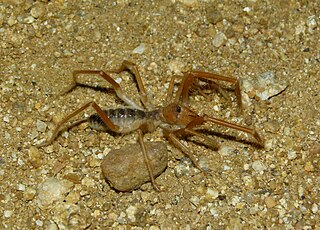 W
WGaleodes is a genus of solifuges or sun spiders. The nearly 200 species in this genus are found in northern Africa, southeastern Europe and Asia. Like other solifuges, they are mainly nocturnal and found in arid habitats. They often have long hairy appendages and are not as stout bodied or dark and contrastingly coloured as some other solifuges. Some Galeodes species are able to produce sounds by stridulation. These are usually raspy or hiss-like and may be imitations of the sounds of vipers, to serve a defensive function. As in other solifuges, mating involves the male depositing a spermatogonia that is manipulated into the female genital opening using their chelicera. The male strokes the female using the palps allowing her to be approached. Females will often feed on males before or after mating. The female then deposits the eggs in a burrow in soil and in some species guards them.
 W
WIxodes hexagonus, also known by its common name the Hedgehog tick, is a tick species in the genus Ixodes. It is a parasite of the European hedgehog.
 W
WIxodes persulcatus, the taiga tick, is a species of hard-bodied tick distributed from Europe through central and northern Asia to the People’s Republic of China and Japan. The sexual dimorphism of the species is marked, the male being much smaller than the female. Hosts include wild and domestic ungulates, man, dog, rabbit, and other small mammals including the dormouse, Amur hedgehog, and occasionally birds.
 W
WIxodes ricinus, the castor bean tick, is a chiefly European species of hard-bodied tick. It may reach a length of 11 mm (0.43 in) when engorged with a blood meal, and can transmit both bacterial and viral pathogens such as the causative agents of Lyme disease and tick-borne encephalitis.
 W
WIxodes uriae, also known as the seabird tick, is a species of parasitic tick known to infect marine birds. It is native to many high latitude areas in the northern and southern hemispheres including Alaska, Canada, Faroe Islands, Iceland, Greenland, England, Scotland, Norway, Finland, the Kola Peninsula, Russia, Patagonia, South Africa and Australia.
 W
WLasiochernes cretonatus is a species of pseudoscorpions discovered in the late 1990s in the Souré cave in Crete.
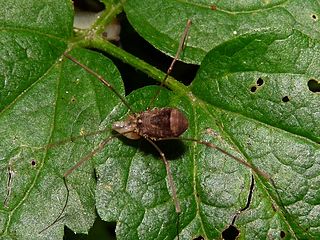 W
WLeiobunum blackwalli is a species of harvestman. It is found in Europe.
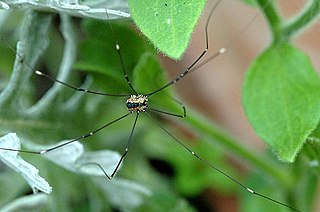 W
WLeiobunum rotundum is a species of harvestman. It is found in the western Old World.
 W
WMegabunus diadema is a species of harvestman distributed in Western Europe, where it has been found in Iceland, Faroe Islands, Western Norway, Great Britain, Western France, Belgium and Northern Spain.
 W
WMitopus morio is a species of harvestman belonging to the family Phalangiidae.
 W
WMitostoma chrysomelas is an harvestmen species widely distributed in Central Europe, British Isles, France and Southeast to Bulgaria.
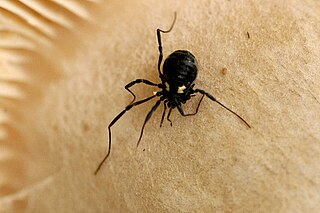 W
WNemastoma bimaculatum is a species of harvestman, in the Nemastomatidae. It is black, with two cream spots on the cephalothorax. It is sometimes known as N. lugubre. It occurs in Britain, Ireland, France, Germany, and Spain.
 W
WNemastoma lugubre is an harvestmen species found in the whole of Europe from the Arctic to the Mediterranean.
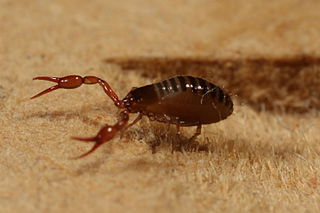 W
WNeobisium carcinoides is a species of pseudoscorpions in the Neobisiidae family. It is found throughout Europe with the exception of Greece, Belarus, and Russia. The type locality is 7 km south of Strasbourg, in the Bas-Rhin department, Alsace, France.
 W
WNeobisium sylvaticum is a species of pseudoscorpions in the Neobisiidae family. It is found throughout Europe with the exception of the Benelux union, the Nordic countries, and the British Isles. The type locality is Frauenholz in Regensburg, Bavaria, Germany.
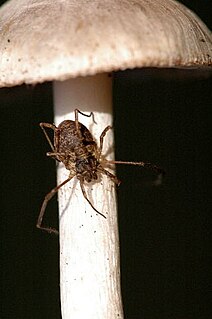 W
WOligolophus is a genus of the harvestman family Phalangiidae with four described species.
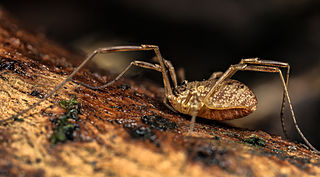 W
WOligolophus tridens is a species of harvestman. It is found in central Europe.
 W
WOpilio canestrinii is a species of harvestman.
 W
WOpilio parietinus is a species of harvestman found in Europe and North America. It is similar to O. canestrinii, but has dark spots on its coxae, and is generally more of a grayish green color. Like O. canestrini, it was often found on house walls in Central Europe, but has by now almost everywhere been replaced by this invasive species.
 W
WPhalangium opilio is "the most widespread species of harvestman in the world", occurring natively in Europe, and much of Asia. The species has been introduced to North America, North Africa and New Zealand. It is found in a wide range of habitats, including meadows, bogs, forests, and various types of anthropogenic habitats, such as gardens, fields, hedgerows, lawns, quarries, green places in built-up areas, walls and bridges. Phalangium opilio is known to feed on Helicoverpa zea eggs, and thus can act as biological pest control for soybean crops. The species is nocturnal, as is typical of opilionids.
 W
WPhyllocoptes eupadi is a mite that chemically induces a pouch gall to develop as a sub-spherical distortion rising up from the upper surface of the lamina of leaves of blackthorn shrubs Prunus spinosa and other Prunus spp. Synonyms are Eriophyes padi (Nalepa) and Phytoptus padi prunianus.
 W
WPhyllocoptes goniothorax is a species of mite belonging to the genus Phyllocoptes, which causes galls on the leaves of hawthorns. It was first described by Alfred Nalepa in 1889.
 W
WPyemotes herfsi, also known as the oak leaf gall mite or itch mite, is an ectoparasitic mite identified in Western Canada in 1923 and subsequently found in India, Asia, and the United States. The mite parasitizes a variety of insect hosts and bites humans, causing red, itchy, and painful wheals (welts). The mites are barely visible, measuring about 0.2-0.8 millimeters; their great reproductive potential, small size, and high capacity for dispersal by wind make them difficult to control or avoid.
 W
WRilaena is a genus of the harvestman family Phalangiidae.
 W
WTetranychus lintearius is a species of spider mite known as the gorse spider mite. It is used as an agent of biological pest control on common gorse, a noxious weed in some countries.
 W
WTrombicula is a genus of harvest mites in the Trombiculidae family. In their larval stage, they attach to various animals, including humans, and feed on skin, often causing itching. These relatives of ticks are nearly microscopic, measuring 0.4 mm (0.01 in) and have a chrome-orange hue. A common species of harvest mite in North America is Trombicula alfreddugesi; in the UK, the most prevalent harvest mite is Trombicula autumnalis.
 W
WVasates quadripedes, the maple bladder-gall mite, is an eriophyid mite in the genus Vasates, which causes galls on the leaves of silver maple, red maple (A. rubrum), and sugar maple (A. saccharum). The gall is rounded, sometimes elongate, and has a short, thin neck. Typically, galls are 2–3 millimetres (0.079–0.118 in) in diameter, and may be numerous on the upper surfaces of leaves. They have an opening in the lower surface. At first they are yellowish-green or bright red, later they become dark red and black.